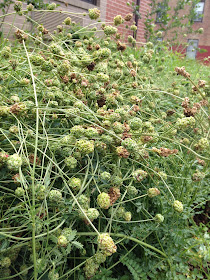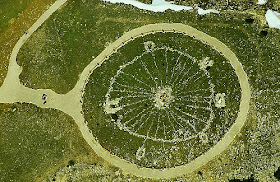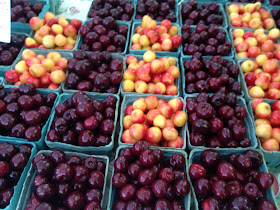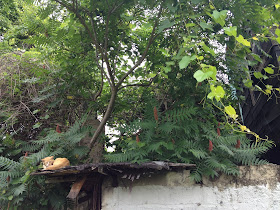Ah, summer.
Long days of blue skies, big clouds, green
trees, colorful flowers, warm rain, tall grass, iced coffee in the morning and
Corona beers at night. You got your
flies, mosquitos and bees, sure, but you also have the hummingbirds and
woodpeckers -- the season of the bear, the bat and the beaver, the ant and the
squirrel.
It’s also the season of sweating on the
couch.
According to the Farmer’s Almanac, the northern
summer solstice begins this week, a stretch of long, long days clocking in at
14 hours and 47 minutes, gray moons in the blue evening skies. If we were cabin-bound in northern Inuit
country, then we might be able to see old Sol, for a brief moment, standing
still in the sunny midnight hour. The origin of the word solstice is a combination of sol for “sun” and sistere
which means “stands still.”
According to the Medicine Wheel, Wabun
the Golden Eagle is flying away from his nest-throne and Shawnodese the Coyote
Trickster begins the next three-moon reign, beginning with the paradoxical
Strong Sun Moon. Although considering
that the sun and the moon share the sky during this season, maybe the
Wheelmakers were on to something there.
If I had any of the spirit of Wabun in
me, then I wouldn’t be here right now, in an air-conditioned urban cabin on
some numbered street in just another grid in just another city somewhere along
this great sprawling megalopolis.
No, I’d be high-tailing it to the Big
Horn county of Wyoming, ten-thousand feet up Medicine Mountain, and I’d be
watching the sun rise along its solstice while sitting Indian-style at the
southern cairn of an actual medicine wheel.
Up on Medicine Mountain, there be one of
the largest surviving Medicine Wheels, seventy-five feet in diameter, over eight
hundred years old, perfectly aligned with the northern summer solstice.
Now that’s the kind of entrance that the
Coyote deserves.
If Wabun the Golden Eagle is all eyes
and wing, then Shawnodese the Coyote Trickster is all teeth and heart and, for
better or for worse, all that the teeth devour and all that the heart ignites:
love, hate, fear, sympathy, envy, jealousy, delight, rage, anger, desire, regret,
hunger.
And so, it is only appropriate, that the
Coyote’s three moons are dominated by the family of trees called the Roses.
 Certain trees dominate certain
seasons. Here in Agricultural Hardy Zone
Seven, I cannot think of a more dominant group of summer trees than the family
Rosaceae, bearers of all that summer fruit.
Certain trees dominate certain
seasons. Here in Agricultural Hardy Zone
Seven, I cannot think of a more dominant group of summer trees than the family
Rosaceae, bearers of all that summer fruit.
It’d almost be easier to say which Zone
Seven fruits are not members of the Rose family. Blueberries and cranberries are not
Roses. They’re Heaths. The persimmon is an Ebony, the grapes are
Grapes, the nuts are Nuts, the tomato is a Night-shade, the pawpaw is a Custard
Apple and the watermelons, the cantaloupes and the honeydews are members of the
Gourd family.
Other than that, it’s all Roses:
strawberries, cherries, peaches, apricots, plums, pecans, raspberries,
blackberries, something called a loquat and a medlar, and later, the apples,
the pears and the quinces. Figs too. Hop flowers and cannabis buds. All related
to the Roses, all part of those hot summer nights.
The only drawback? These are not common city trees. Most of these Rose trees are cultivated and trained, pruned and domesticated, laid out in rows in orchards and fields, far away from the urban grid. For citybilly tree-hunters like myself, the odds are stacked against us. We’re more likely to find their droppings at local farmers’ markets than the actual fruit trees themselves.
But here’s the thing: never tell Jon
Spruce the odds.
BRIGHT
ROSES, BIG CITY
The namesake of the Rose family is not
hard to find during this moon, not at all.
They are popping out and brightening up the streetscapes up and down the
entire city.
Ain’t that just like Coyote?
To place those big, flashy, fragrant hotshots of a flower right atop a woody, tangled bramble. Forget those prize-winning beauties you see indoors under artificial lights in flower shows inside convention centers. The natural rose plant is a prickly mess of stout stems that braid around other plants and trees like a vine. In fact, many people believe that those sharp, curved prickles were adapted by the plant to help it climb over the forest scrub to reach the open sunlight shafts tunneling through the tree tops.
For more pictures of my rose-photo
quarry, check out the Medicine Moon page of this blog. For the moment, I’m more interested in
finding the rose’s siblings, the fruit trees.
It’s summer and I’m hungry, broke and
impatient. I want fruit. And I’m going to get me some fruit even if I have
to eat it off the streets.
According to the small but trustworthy cabal
of citybillies following this blog, the best place to go foraging for urban
fruit is West Philly. It didn’t take me
long to stake my claims.
PRESTON
STREET FORAGING
My first attempt at urban fruit foraging
took me deep into the blighted crannies of West Philly, north of Lancaster
Avenue, on the borderlines of the Mantua and Powelton neighborhoods. Along such borders, there is something fruity
going on.
In fact, there is something really
interesting going on right along Preston Street in between 40th and
41st Streets. There is a
building there, a group home of some sort, completely unlabeled, which makes me
think that it’s either a half-way house or a shelter for battered women. It’s the cynic in me.
Whatever is going on inside this
building, it’s pretty clear that somebody here is hungry. The entire yard out front is a landscaped grove
of Rose plants. This unsuspecting corner of the inner city? Might as well call it a farm, really.
I see blackberries and raspberries and even a grouping of tall shrubs bearing tight clusters of red berries, so bright that I was sure they must be poisonous.
I also saw an overgrown thicket of hop
flowers.
Do I see a Preston Street Rehab Pale Ale in the future?


Around the corner, there is a whole swath of wild strawberry suckers covering the ground in front of the red-brick building.
When you go wild fruit hunting, it’s
best practice to keep your radius wide and circling. A patch of strawberry suckers very rarely
stays put…and sure enough, in the grassy vacant lot behind the unmarked
building, I spied even more wild fruit popping out of the ground…but my
attention was diverted by the sumac tree growing over the dilapidated wall at
the edge of the vacant lot.
Sumac is not one of the Rose trees, but this is still a good find.
This is a native wild tree, very rarely planted, but unmistakable, thanks to its big, upright bud of small, tight red flowers. This sumac flower is used as a spice all around the world. Middle Eastern families sprinkle it, dried, over salads. I know one chef in town that uses it to season oven-roasted lamb ribs.
The Rose tree hunting didn’t stop there. Right across the street from the vacant lot, in front of a boarded-up house, I found a peach tree, still bearing fruit.
The house itself was long
abandoned. The house was obviously
empty, the lease up, the door locked and bolted and the front yard? Gone to pot.
And yet, here was a peach tree, once planted, still putting out
fruit.

Of course.

Of course.
Going urban fruit foraging, one thing
becomes abundantly clear: a tree is a factory.
FRUIT
MACHINES
There are so many moving parts to a
tree. I don’t care that it’s just
standing still, rooted down in one spot.
I still say a tree is just one collection of moving parts. You don’t expect the Tastykake factory to
move around, do you?
Well, that’s what a tree is. It’s a factory, a machine, an engine that
burns sunlight and rain, dew and moonshadow.
I’m trying to learn how but, for some local trees, all those biofuels
turn into sweet summer fruit.
And it can’t be stopped. Once you turn the switch on, it'll stay on.
The roots, the trunk, the bark and stems
and flowers and leaves, the xylem and phloem, the wood and the sap: they all
have their own function and use. It
usually involves some sort of way of catching, holding and transforming
sunlight and water. I’m only on the
verge of understanding it myself.
The thing is, once you plant this
machine into the ground, you can’t really stop it from doing its work. A true fruit grower knows how to train and
prune the tree to maximize its productive output but, really, left unattended
and left to its own devices, the tree just can’t stop working on its own.
That’s the lesson you learn while
hunting for street fruit trees.
All trees bear fruit, I know. You got acorns, samaras, inedible nuts and
beans, edible nuts and beans, spiky monkey-balls, pine cones, juniper berries,
ginkgo nuts, inedible berries, edible berries, poisonous berries, and sweet
summer stone fruits. Botanically, it’s
all fruit.
The fact that humans pay money for some
fruit is inconsequential to the inner workings of the tree.
I went up and down West Philly, mostly
around the small neighborhood behind Clark Park. In maybe a ten-block radius, I ended up
catching about a dozen street fruit trees.
I could plot my path around the neighborhood, like some stupid Family Circus comic, but for once I’ll let the following
pictures do all the talking.
WEST PHILLY CITY FRUIT DROPPINGS
WEST PHILLY CITY FRUIT DROPPINGS
 |
| Apricot tree on the street between... |
 |
| ...48th and 49th Street on Baltimore Avenue. |
 |
| ...green plums on a plum tree |
 |
| Next to the apricot tree... |
 |
| Raspberries on 47th Street... |
 |
| ...between Springfield and Baltimore Avenue. |
 |
| ...an apple tree on 47th Street. |
 |
| Not a banana tree... |
And lots more...I found three other apple trees, two other peach trees and...well, I'm saving my gold mine for a later post, I promise, but here's a sneak peek:
In my search for urban orchards, I found a hidden patch of native fruits in the middle of a block on Chester Avenue.
Inside this sunlit-slanted grove, I found a cherry tree, an apple tree, a gooseberry bush, elderberries, a hardy orange tree, a pawpaw, a grape vine and a northern kiwi vine.
Yeah, kiwis.
Those are kiwis. Don't worry. I'll be back. Get ready for City Pickings II: Late Fall Summer Harvest.
THE LONG WAIT
Hunting for fruit trees in the early summer is just a tease though. I’ve seen some early peaches at farmers’ markets but the real bounty is just about to begin, thanks to these long, hot days of summer.
I’m hungry for it. I cannot wait to stock my fridge and fill my
belly.
Every first fruit of the year becomes a
moment: that dark winey burst of a cherry…the fuzzy musk of a peach…the grassy
arabesque of an apricot and the candy satin of a plum…and later, the woody
sugars of the pear and the brisk crunch of all those apples.
Every week now, from the Strong Sun Moon
all the way to the Ducks Fly Moon of late October-time, these Rose trees will
be working, sun-up to sun-down, to produce all that fruit.
They’re working very, very hard.
Me? Jon Spruce?
Me? Jon Spruce?


























Don’t risk your safety by taking care of your trees yourself. Check out Spot a fallen tree? Call tree removal queens today!
ReplyDeleteRegarding the "grouping of tall shrubs bearing tight clusters of red berries, so bright that I was sure they must be poisonous." I have these in my yard too, and just learned that they are Nanking cherry bushes, which ARE indeed edible! I too was suspicious of how big, bright red, and oddly placed the berries are on the stem. But now I know they are definitely Nanking cherries. Enjoy!
ReplyDelete